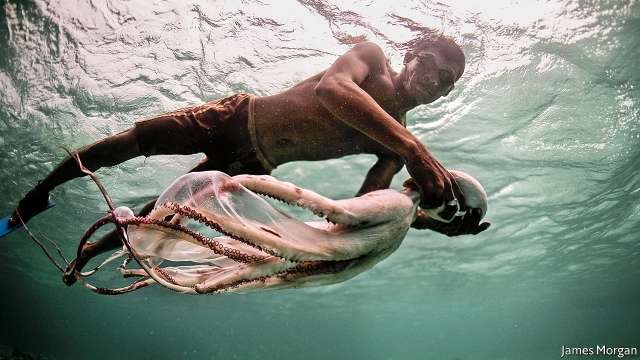Unsurprisingly, their diving abilities are prodigious. They sometimes descend more than 70 metres, and can stay submerged for up to five minutes, using nothing more than a set of weights to reduce buoyancy and a pair of wooden goggles fitted with lenses fashioned from scrap glass that are resistant to distortion by the pressure at such depth. Since the Bajau have lived like this for a long time (historical evidence suggests at least 1,000 years), many researchers have speculated that they carry genetic traits which adapt them to their remarkable lifestyle. Now, as they report in Cell, Melissa Ilardo and Rasmus Nielsen of the University of California, Berkeley have shown that this is so.
Immersing someone’s face in cold water and thus requiring him to hold his breath triggers what is known as the diving response. This involves a lowering of the heart rate to conserve oxygen; the redirection of blood from surface tissues to the most oxygen-sensitive organs, such as the brain, the heart and the lungs; and contraction of the spleen, an organ that acts as an emergency reserve of oxygenated red blood cells, so that an increased supply of these cells is released into the bloodstream. Ms Ilardo and Dr Nielsen decided to investigate whether the genetics and anatomy of the Bajau promote these responses.
To do so, Ms Ilardo travelled to Indonesia and recruited 59 Bajau who were willing to give her samples of saliva for DNA analysis and also to have their spleens measured ultrasonically. To act as controls, she also recruited 34 members of the Saluan, a group of landlubbing but closely related neighbours of the Bajau. The spleen scans showed that the Bajau’s are 50% larger than those of the Saluan—a difference unconnected with whether an individual was a prolific diver or one who spent most of his time working above the waves on a boat. This suggests that it is Bajau lineage, rather than the actual activity of diving, which is responsible for a larger spleen.
DNA analysis told a similar story. One intriguing result was a mutation in part of the Bajau genome that regulates the activity of a gene known to be involved in controlling blood flow, such that blood can be sent preferentially to oxygen-hungry vital organs. Another was a mutation in a gene responsible for the production of carbonic anhydrase, an enzyme that slows the build up of carbon dioxide in the bloodstream, a phenomenon that is associated with extreme diving. Changes in genes associated with muscle contractions around the spleen and with responses to low oxygen levels also turned up.
Putting these results together, Ms Ilardo and Dr Nielsen argue that the need to collect food by diving has indeed led to the evolution, in the case of the Bajau, of a group who are literally born to dive. Whether that evolution was driven by the failure of those who could not dive well to collect enough food to sustain a large family, or rather, of their dying in the attempt to do so, remains to be determined.
The Economist
More about: DNA
















































